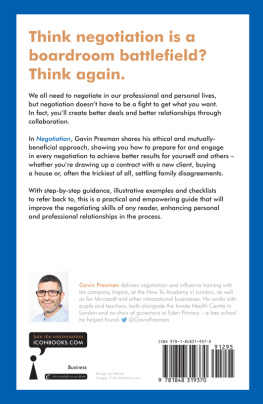THE DIGITAL AGE HAS changed everythingincluding negotiation.
Ten years ago, negotiations might take place in a conference room, with the parties facing off against one another backed by PowerPoint slides containing myriad bullet points, charts, graphs, and statistics. Weeks or months might have gone into preparation for these sessions. Today such negotiations are often completed in a matter of hours, not days and weeks. Sometimes, important deals can even be struck in minutes.
This is the result of the age in which we liveone in which communication occurs at the speed of thought, in which e-mails zip back and forth and virtually everyone is plugged in twenty-four hours of every day through cell phones, BlackBerries, iPads, and every other device you can imagine.
The basics of negotiating have not changed. All the old rules still apply: you must know your bargaining position, your walkaway point, and the other partys strengths and weaknesses. You must still understand what tactics and strategies work and which should be discarded. What has changed in todays negotiations is speedthe speed at which the exchanges take place and the vast increase in the amount and speed of resources that are available to the skilled negotiator.
Speed shouldnt frighten you. Rather, you should welcome it, since it means you can be more productive, more informed, and more effective. Youll plunge into the waters of negotiation and emerge triumphant. Why? Because youll know how to gather information and make the best use of it to get what you wantwhen you need it.
Chapter 1
The Split-Second Imperative
IMAGINE THAT YOU ARE the CEO of ConWireless, a medium-sized electronics manufacturer. For some time youve been casting about for another, similar company to merge with in order to expand your retail operations. Now youve found someone: Electronics Shack, a company with a chain of stores throughout the country. It seems a perfect match. The Board of Directors has approved exploratory talks with the aim of a merger between the two companies, and upper management at Electronics Shack has responded favorably to your overtures. Your staff has done extensive research; youve stared at seemingly endless files and spreadsheets and mastered reams of facts and figures about Electronics Shack. Youve discussed the matter in countless meetings with the board and your management team. Its all done. Now youre ready to go.
Though the preparation for this moment seemed endless, you know that as the talks begin everythings about to speed updramatically. You live in an age of split-second decision making, when every issue, every detail, every concern of each side will have to be addressed and resolved quickly. Youll have to discuss with your counterpart of Electronics Shack what would constitute a fair deal for the stockholders of the two companies. Who should be on the new board of directors? How should the responsibilities of manufacturing and retail be divided?- For that matter, who should be CEOyou or someone else?
On a more nitty-gritty level, youll need to arrange new titles for executives, possibly new offices for corporate headquarters to accommodate a larger staff, and how and at what pace the merger, if its concluded, will take place. Youll have to agree on the best way to announce it, both to the public and to your employees, many of whom may be concerned for their jobs in the new company.
No matter how many items you add to your To Do list, it always seems as if there are more. Thats because complex projects such as this touch many people. In fact, in todays interconnected world, anything you do touches many people. Those potentially affected can include everyone from top management to a range of employees throughout the organization, including the IT department, manufacturing, the finance department, human resources, warehouse employees, and others. The project may also affect those outside the organizationin this case, your customers and various suppliers, all of whom will have to adjust to working with the larger merged company.
All these parties, actions, costs, terms and conditions, and deadlines will require agreements. And those agreements will have to be made quickly to match the pace of the rest of the corporate worldespecially your competitors, wholl be watching you eagerly, looking for any signs of weakness on your part. These agreements in turn require negotiationsnegotiations to come to terms with people throughout the organization so that they can work together in a new structure with a minimum of disruption. Successful negotiations with all these parties will ultimately depend on you; no one else will do it for you. Youll have to get management on board with each of the final decisions you negotiate, up to and including the final due date for the completion of each stage of the merger.
DangerFast Track Ahead
This is the reality of todays fast-paced world. Negotiation is a basic part of life, and it happens all around us. Although some might think that negotiating about a project takes away time from managing it, in point of fact negotiating isispart of managing the project. Its a big part, and a bigger part than ever in most projects encountered and tackled in todays commercial world. Why? Well discuss that later.
All this negotiating has to be done faster than ever before. These days, business, technology, and productsand mergersall move at a blinding speed. So does your competition, and if you dont keep up with them, youll be left behind. In the case of the merger mentioned above, for instance, you might typically get three to six months to complete the integration of the two companies. Within that time, the entire commercial landscape around you can change.
The result, as indicated in the introduction, is that negotiations occur very quickly. Often they are tucked into odd moments of the day as executives and employees tap relentlessly on their BlackBerries.
These days there is no longer time to hold face-to-face meetings with the players involved. Some part of the negotiationsmaybe the whole thingwill be done by e-mail, phone, IM, and even text.
The goal is to get what you need, get what you want, as quickly as possible so you and your organization can move forward without delays. But even at this accelerated pace, you must beware of harmful concessions or oversights. Thats your goal.
The tactics you employ come from an assortment of traditional negotiating techniques, all sped up to accomplish the win-win. But even when the negotiation has been concluded and the terms agreed upon, youre not donewhen running fast, in split-second mode, its important to come away with what you want, as well as to preserve a long-term relationship with the other party. Why? Because youll be working with these people in the future.














